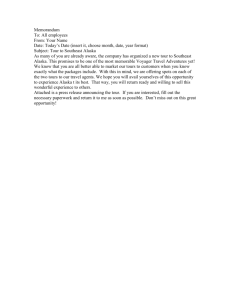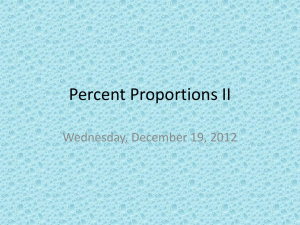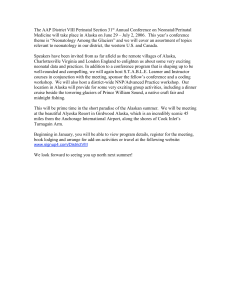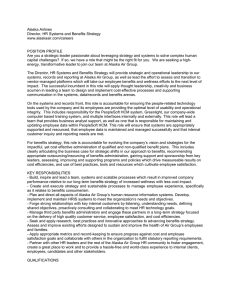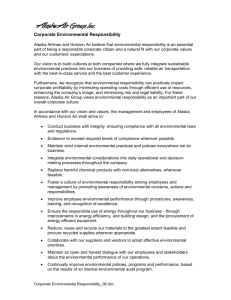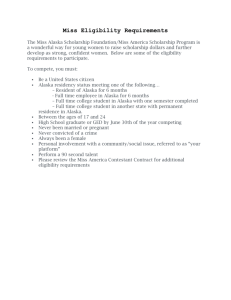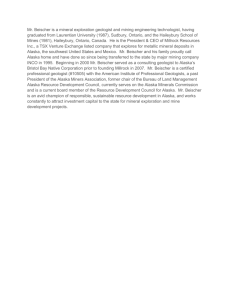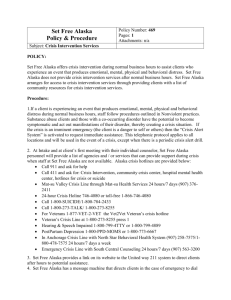Environmental Collaborations Occurring in Southeast Alaska
advertisement
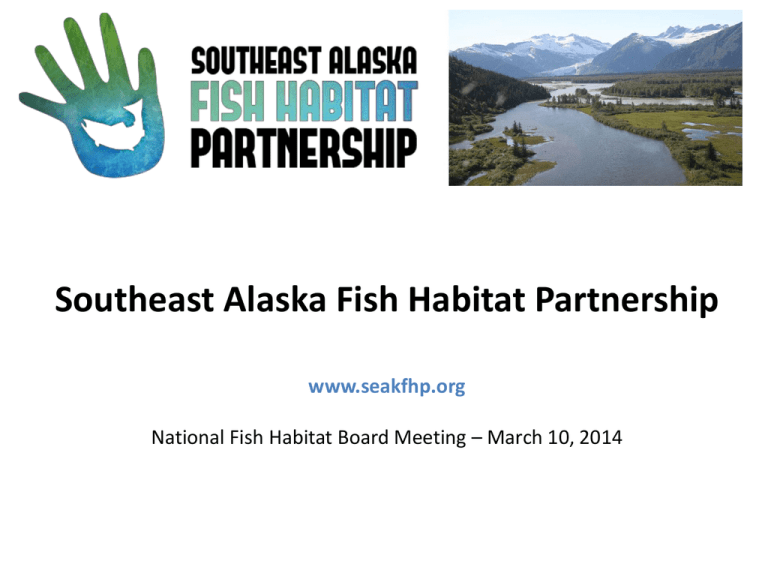
Southeast Alaska Fish Habitat Partnership www.seakfhp.org National Fish Habitat Board Meeting – March 10, 2014 Introductions Neil Stichert – USFWS Juneau Field Office, SEAKFHP Committee Co-Chair Deborah Hart – SEAKFHP Coordinator Roger Harding – Alaska Department of Fish and Game (ADF&G), ADF&G Liaison to all Alaska FHPs David Wigglesworth – USFWS – Region 7, Regional Coordinator Presentation Objectives • Provide overview of the Southeast Alaska Fish Habitat Partnership • Demonstrate how the SEAKFHP has risen to become a robust partnership • Expand our dialogue with the NFHP Board Developmental Milestones 2010 – Working Group Forms – Hosted formal session at AFS Alaska Chapter meeting 2011 – Candidate FHP Status Granted – Initial coordination funding secured 2013 – SEAKFHP Matures as Fully Functioning FHP – – – – Formalized Science and Data Comm. Provided briefing to NFHP Board Developed draft strategic plan Co-hosted Southeast Alaska Watershed Symposium 2012 – SEAKFHP Formalizes – Coordinator hired – Governance and partner affirmations established 2014 – Applies for NFHP Board Recognition – Incorporated regional review into draft strategic action plan – Completed NFHP recognition application – Presented to NFHP Board at March meeting Who We Are As a Partnership… • • • • • • • • • • • • U.S. Fish and Wildlife Service NOAA U.S. Forest Service Alaska Department of Fish and Game Alaska Department of Environmental Conservation Central Council Tlingit Haida Indian Tribes of Alaska City and Borough of Yakutat Southeast Alaska Watershed Coalition Trout Unlimited The Nature Conservancy Sitka Conservation Society University of Alaska Southeast 5 …And as part of the people and economy of Southeast Alaska • 33 communities- Only three connected to mainland road system • Multi-cultural- Tlingit, Haida, Tshimshian -organized as tribes and corporations • 1,500,000 visitors each year Economy: • Fishing • Tourism • Government • Mining • Timber Harvest A Region With Strong Connections to Fish • 96% of Alaskans surveyed say salmon are essential to the Alaskan way of life. • Human Use of Salmon – Nearly 90% of rural households in Southeast Alaska use salmon. – On average, rural residents use 75 pounds of pink, chum, coho, Chinook, and sockeye salmon annually • Robust subsistence, sport, and commercial fisheries support this economy with salmon use values exceeding $466,000,000 annually in Southeast* *Economic Contributions and Impacts of Salmonid Resources in Southeast Alaska, 2010. TCW Economics for Trout Unlimited, Alaska. Southeast Alaska A complex landscape and biogeography Largest contiguous coastal temperate rainforest in the nation, home to the Tongass National Forest Covers nearly 45,000 mi2, with shoreline length > 16,000 miles Tides range -4 to +21 feet > 1,000 named islands > 5,000 mapped anadromous fish streams > 20,000 lakes and ponds 8 The Tongass National Forest is globally recognized as important habitat for wild Pacific salmon Aquatic Habitat Stressors in Southeast Alaska • Development encroachment on riparian corridors and streams • Fish passage culvert barriers (1,200+) state, federal and private • Existing and expanded mining activities and exploration • Hydropower potential • Climate change • Post-industrial logging landscape400,000 acres – state, federal, and private ownerships Stressors – Direct Effects Gravel Removal – Twelvemile Creek, Prince of Wales Island Logging in the 1950s to early 1980s Streamside Harvest & Wood Removal – Iris Creek, Kruzof Island Large wood removal – Saginaw Creek, Kuiu Island 11 Stressors – Indirect Effects Resultant watershed condition declines due to: • stream erosion and widening, decreased pool depth, loss of floodplain connections • backlog of road maintenance • restricted access to fish habitat upstream of culverts Southeast Alaska Fish Habitat Partnership Conservation Priorities: Protect fish habitat in freshwater, estuaries and near-shore areas Maintain and restore water quality and quantity in the region Restore fragmented and degraded fish habitats in impacted areas – Support region-wide restoration prioritization and planning – Align organizational approaches to fish passage at road/stream crossings – Facilitate regional adoption of best management practices for restoration and monitoring Tongass NF Priority Watersheds 2014 Identify Priority Watersheds for Restoration • Local values - engage stakeholders for feedback and support • Acting now will prevent continued decline of watershed condition • Compared to lower 48, small investments have large impacts – our salmon can immediately use restored habitats. Partner Services Foster interagency & regional communication Facilitate regional funding opportunities Support regional assessment sharing Provide - project technical review and endorsement - annual symposium and event facilitation Elevate regionally shared conservation priorities 16 Accomplishments Organizational Development • • • • Broad and diverse partner support Formal governance structure Interim operational funding support Strong NFHP relationships Partner Services • • • • Promoting communication and cooperation Robust website and archive Public events Project endorsements Strategic Action Plan • • Promoting regional conservation priorities Highlights a region with strong capacity for scientific assessment Southeast Alaska Fish Habitat Partnership Next Steps Implement Direct Actions from Strategic Plan – Outreach to new partners (native corporations, industry, municipalities, marine stakeholders) – Maintain focus on partnership services - New Communications Committee – Align 2015 USFS Watershed Condition Framework and the National Fish Habitat Assessment activities in Southeast Alaska Establish 2014 Coordinator and Committee Work plans – Support 2014 AFS/AWRA Conference – Support Coastal FHP presence at RAE/Ocean Society Conference Develop Strategy for Long-term Operational Support – Current funding secured through October 2014 – Exploring 3-yr operational funding options Thank you and we welcome your questions 19
